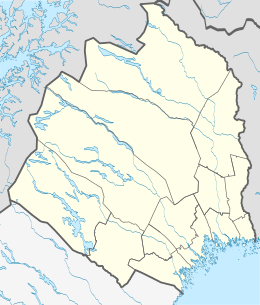Boden Fortress Radio Bunker
Boden Fortress Radio Bunker (Swedish: Radiobunkern i Boden) is a communications bunker, part of Boden Fortress, outside the city of Boden, Norrbotten, in northern Sweden. It was used for the first radio broadcast in Swedish history.
| Boden Fortress Radio Bunker | |
|---|---|
Radiobunkern i Boden | |
| Boden, Norrbotten, Sweden | |
 The Radio Bunker as it appears in 2011 | |
 Boden Fortress Radio Bunker | |
| Coordinates | 65.8447°N 21.6442°E |
| Type | Communications bunker |
| Site information | |
| Owner | Government of Sweden |
| Controlled by | Sweden |
| Open to the public | No |
| Site history | |
| Built | 1916 |
| Built by | Government of Sweden |
| In use | 1916–1975 |
| Materials | Concrete, steel |
History
The first radio station at the site was finished by 1914, originally built for the Swedish Navy,[1] and was located south of Degerberget Fort on the "Great Mire" (Stormyren) bog, also known as the "Radio Mire" (Radiomyren).[2] The station was rebuilt as a communications bunker in 1916, a concrete construction with one floor above ground and another below ground, which was supposed to withstand fire from most weapons of that time.[3][4] The original station was equipped with three 108-metre tall radio masts,[5] while the new bunker had an antenna stretched between two 20-metre masts.[3]
The bunker was first used for radiotelegraphy to keep Boden Fortress in contact with other parts of the country.[4] It also played an important role during the First World War as a medium for exchange of prisoner of war telegrams between the Russian Empire and the Central Powers. Around 7,900 such telegrams were sent during one year.[2][4] The station was also used for the contact with Sveagruva on Svalbard and for radiotelegraphy with ships in the Gulf of Bothnia.[4]
At 15:00 local time on 12 July 1921,[6] the first radio broadcast in Swedish history was sent from the bunker.[3] Radio commissioner Axel Jenner conducted this historic broadcast, with the Swedish king Gustav V listening some 35 km away in Luleå.[2] Due to a misunderstanding between Jenner and his radio telegrapher, the first words uttered in the broadcast were "jävlar anamma",[2] a Swedish profanity in the style of "damn" or "darn", literally meaning "embrace the devils".
Radiotjänst, the Swedish national radio broadcaster, took control of the broadcasts from the bunker in 1925. The bunker was put out of operation 1 January 1975 and ten years later in 1985, it was decommissioned by the Swedish Army.[4] The bunker has since decayed, but in 2010 a project was initiated to have it declared a historic building.[2][5]
Citations
- Strömholm 1933, p. 35.
- Leffler 2010.
- Högberg 2006, p. 222.
- Johansson 2011.
- Zerpe 2010.
- Försvarsmuseum 2011.
References
All sources in (in Swedish) unless otherwise noted.
- Books
- Högberg, Leif; Ohlsson, Jan Erik (2006). Militär utflykt!: en vägvisare till militärhistoriska sevärdheter i Sverige. Skurup: Fort & Bunker. ISBN 91-973900-8-9.CS1 maint: ref=harv (link)
- Nyström, Bror Oscar (ed.); Skeppstedt, Sven (ed.) (1990). Boden: fästningen, garnisonen, samhället. Västervik: Ekblad.CS1 maint: extra text: authors list (link) CS1 maint: ref=harv (link)
- Strömholm, Fredrik (1933). Boden, fästningen och staden: några minnesblad. Boden.CS1 maint: ref=harv (link)
- News
- Leffler, Lena (2010-04-12). "Här föddes ljudradion". Norrländska Socialdemokraten. Retrieved 2011-11-24.CS1 maint: ref=harv (link)
- Zerpe, Håkan (2010-02-12). "Operation Rädda radiobunkern". Norrbottens-Kuriren. Retrieved 2011-11-24.CS1 maint: ref=harv (link)
- Online
- Dig Maps AB (2001). "Bodens fästnings karta". Archived from the original on 2006-06-14. Retrieved 2011-11-24.
- Försvarsmuseum (2011). "Bodens Radio". Retrieved 2011-11-24.
- Johansson, Johan (2011-10-05). "Motion 2011/12:Kr304 Byggnadsminnesförklaring av radiobunkern". Retrieved 2011-11-24.CS1 maint: ref=harv (link)
External links
| Wikimedia Commons has media related to Boden Fortress Radio Bunker. |
- Boden Radio (in Swedish)